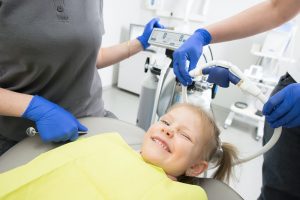 Back-to-school season is here again, and other than the usual run for school supplies, it is also essential not to forget the back-to-school dental checkup. Scheduling a back-to-school dental exam can put you at ease, knowing that your child will be able to focus at school without missing any lessons due to tooth problems.
Back-to-school season is here again, and other than the usual run for school supplies, it is also essential not to forget the back-to-school dental checkup. Scheduling a back-to-school dental exam can put you at ease, knowing that your child will be able to focus at school without missing any lessons due to tooth problems.
Importance of Dental Exams in Children
Tooth decay is one of the most common dental conditions in children. In fact, more than half of children between the ages of 5 to 9 have a dental cavity. Most children are afraid or intimidated by dental visits, so they may be hesitant to say that they are experiencing tooth pain. This can significantly affect their classwork and ability to eat. Additionally, most children hate brushing and do not brush properly, which can lead to dental problems in the following years.
With expert dental care, cavities and other dental problems can be easily identified and treated in their early stages. Children need to have regular dental checkups even when their teeth seem to be in good condition. This is because a comprehensive dental exam helps dentists to monitor or identify any problems with teeth development.
What to Expect in A Back-To-School Dental Exam
Explain to your child the importance of a regular dental exam and how it helps keep their teeth strong and healthy. If your child is nervous or anxious about the dental visit, try to assure them that all will be well and explain what to expect during their appointment.
Various dental procedures are performed during a dental exam, such as professional cleaning services to prevent tooth decay and protect teeth from cavities. If there is a cavity problem, fillings and dental sealants are applied at the back of the molars to prevent decay build-up and cavities. Dental fillings are used to fix holes and can be performed using a laser. The laser technique is pain and injection free, so your child will be comfortable during the procedure.
If your child’s teeth are not in a straight line, your dentist may recommend fitting them with braces to help align their teeth. Braces are recommended for children between 10 to 14 years old. They usually adjust the bite and shift the teeth, so it is essential to get them at a young age before teeth settle into puberty.
Your dentist may also check the condition of your child’s milk teeth because temporary teeth determine the growth of healthy adult teeth.
The dentist may also conduct an X-ray to monitor tooth growth, check the teeth’ roots’ health, and identify dental cavities and decays. The dentist may also use metal scalers to scrape hardened plaque and keep tooth decay at bay. X-rays help identify and solve any dental problem before it gets worse. Regular X-ray exams are not recommended and should only be conducted when needed.
The dentist may also use fluoride treatments that are brushed over the teeth or inserted into a dental tray and put in the mouth for a few minutes. Fluoride treatments typically include gel, a unique solution, or foam. Fluoride strengthens the enamel and protects the teeth from cavities.
If your child is active in sports, your dentist may recommend a mouth guard to protect their cheeks, gums, and teeth in case of injury. For kids who already have a mouth guard, the dentist can help identify if it is worn out and replace it. The dentist may recommend replacement if the teeth have outgrown the mouth guards. Mouth guards are also beneficial for kids with braces to help protect them during sports.
Early Detection of Dental Problems Can Help Keep Your Child in School
According to statistics, children with dental problems perform poorly in school compared to those with healthy teeth. Dental problems are the primary cause of absenteeism in schools.
Absenteeism can affect your child’s performance in school. Dental problem symptoms significantly contribute to a lack of concentration during learning. Taking your child to regular dental checkups is essential to avoid these problems. Summer is the best time to take your child for a dental checkup since there won’t be interruptions in their learning. Dental checkups are recommended twice a year when you have a less hectic schedule.
Replace Your Child’s Old Toothbrush Regularly
Frequently change your child’s frayed toothbrush because the bristles are more abrasive and ineffective in cleaning the teeth and removing plaque along your child’s gum line. As you stock up on school supplies, don’t forget to include several toothbrushes. Toothbrushes should be changed every three months or immediately after recovering from an illness.
2 × 2 Rule
Remember to follow up on your child’s dental hygiene practices and let them adhere to the 2 × 2 rule when brushing, which means brush twice daily for 2 minutes. Encourage your child to minimize or avoid sugary foods that may cause cavities and tooth decay. Ensure they consume a balanced diet rich in foods like milk, cheese, eggs, fish, carrots, vitamin C, melons, cucumbers, water, and natural yogurt, which are essential for the strength of teeth.
Last Word
Back-to-school dental exams are the way to go to keep your child’s teeth healthy in the long run. Dental checkups also build healthy relationships between your child and their dental practitioner. Schedule an appointment with Children’s Dentistry of San Diego for a healthy, bright smile.











